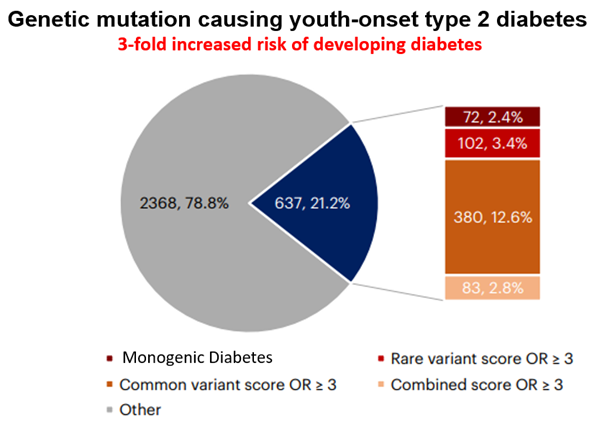First identification of genetic characteristics of youth-onset type 2 diabetes
- SNUH announces the results of the world’s largest type 2 diabetes genome analysis in children and adolescents
- youth-onset type 2 diabetes: 2 out of 10 people have diabetes-related genetic mutations
- The same genetic mutation increases the risk of developing diabetes more than three times in children and adolescents compared to adults.
Recently, an international joint research team announced the results of the largest-ever genome analysis of youth-onset type 2 diabetes. It has been confirmed for the first time that type 2 diabetes that develops early under the age of 20 has different genetic characteristics from those of the type 2 diabetes that develops in adults.
On February 28th, a joint research team including Professor Kwak Soo Heon of Seoul National University Hospital and Professor Jason Flannick of Boston Children's Hospital, as well as Harvard and MIT, announced the results of a study that analyzed the genomes of 3,005 patients with youth-onset type 2 diabetes and identified their genetic characteristics.
Type 2 diabetes is a disease in which blood sugar levels are higher than normal due to poor blood sugar control ability and is a prevalent disease among adults. However, the rate of its frequency has recently been increasing among people under the age of 20. When this disease develops in children and adolescents, caution by patients is needed as blood sugar control becomes more difficult and the risk of complications increases with age.
In particular, youth-onset type 2 diabetes is more likely to be influenced by family history than in adults, so it appears to be highly affected by genetics. The genetic variants that cause diabetes can be distinguished as follows ▲ Common variant (common, but weak genetic influence) ▲ Rare variant (very rare, but strong genetic influence) and▲ Monogenic diabetes rare variant (rare mutations that cause rare diseases such as monogenic diabetes, such as GCK and HNF1A).

The research team conducted full-length exome sequencing on 12,000 patients and control groups to identify genetic mutations that cause youth-onset type 2 diabetes.
As a result, 2 out of 10 patients (21.2%) had a causal gene that increased the risk of developing diabetes more than three times.
Among them, the ‘Monogenic diabetes rare variant’ was 2.4%, which actually means that patients with youth-onset type 2 diabetes were suffering from a different type of diabetes. Monogenic diabetes differs from typical type 2 diabetes in that it can be treated with oral medication or may not require treatment at all.
In addition, ‘rare variants other than monogenic diabetes’ were 3.4%, and ‘Common variants’ associated with the development of type 2 diabetes in adults were 12.6% in the sample.
Until now, in clinical practice, diabetes types were classified based on symptoms, but based on these results, the research team emphasized that a genetic approach is important for accurate diabetes diagnosis and treatment.
Additional analysis showed that even with the same type of genetic mutation, the risk of developing type 2 diabetes was greater in children and adolescents than in adults. The actual impact of ‘common variants’ on the development of diabetes was 3.4 times greater in children and adolescents than in adults, and ‘rare variants’ were 5 times greater.
In other words, the research team explained that genetic factors are relatively more important in youth-onset type 2 diabetes than in adults, and in rare variants are especially important.
Meanwhile, the clinical characteristics of youth-onset type 2 diabetes were confirmed to vary depending on the frequency of individual genetic mutations. For example, patients with the ‘common variant’ developed the insulin resistance that accompanies adult type 2 diabetes. Additionally, patients with ‘rare variants’ had the characteristic of having a younger age of onset.
In addition, genes such as obesity-related MC4R, ATXNL, and insulin secretion-related HNF1A were newly identified as being associated with the development of youth-onset type 2 diabetes.
Professor Kwak Soo Heon (first author) of the Department of Endocrinology and Metabolism said, “Through this study, we have greatly improved our understanding of the genetic structure of youth-onset type 2 diabetes, which was not clearly known before. As a result, we expect to be able to improve our understanding of diseases not only in diabetes but also in other chronic diseases through this genetic approach.”

[Picture] Professor Kwak Soo Heon of the Department of Endocrinology and Metabolism